Joel Embiid: 'I'm The Process'

On the 40th floor of a luxury apartment building in downtown Philadelphia, Joel Embiid sits on the edge of his bed and prays for health. He used to cry when he prayed, and he is not even a crier, but he would flex his foot and remember his brother and feel the tears slick against his stubble. “Why me?” he wondered. “Why my family?” His parents were in Cameroon, grieving for one son and fretting about another. But as much as Embiid missed them, he could not bear to show his face back home until those prayers were answered.
He was living alone in the Residences at the Ritz-Carlton, eating meals prepared by a rotating cast of private chefs, who always seemed to leave his steak and chicken rarer than he liked. He doesn’t know how to drive, so he walked, occasionally ducking into a nightclub where he’d nurse a Shirley Temple before strangers inevitably encircled him and asked about the troublesome foot. Then he’d retreat to the Ritz, in time for the West Coast games on League Pass, and another interminable night of FIFA or Madden. “I was a vampire,” Embiid says. He wasn’t allowed to practice, which meant he didn’t have to rest, or so he told himself. He slept in the afternoon.
He could look at the Clippers’ Blake Griffin, a shining example of another heralded rookie who lost his first season to injury. But Embiid, taken by the 76ers with the No. 3 pick in 2014, lost his first two seasons as the fractured navicular bone in his right foot refused to heal. When he was not rehabbing he was mourning, because between surgeries his 13-year-old brother died after a runaway truck careened into a Cameroonian schoolyard. Embiid was close with Arthur, a spiritual boy who handed out crosses to classmates and donated toys to the poor. But he had not seen him since leaving Cameroon for the United States in 2011 to pursue a basketball career. Grief and guilt, that vicious double-team, enveloped him.
First from the bench, then from a suite, Embiid watched the 76ers lose 136 games while changing general managers, overhauling training staffs and moving practice facilities. He became an emblem of frustration with the franchise, as well as fascination. Maybe the Sixers were stupid to have spent such a high pick on a 7-foot center they knew was hurt. Or maybe they were genius, the rare organization (the only organization?) willing to wait for a Dream-shaking, floor-stretching, rim-protecting prospect the likes of whom arrive once a generation. Nobody could judge the graceful giant until he mended, body and soul. Every pre-game workout became a spectacle, every off-season Instagram video a blockbuster.
Embiid appeared, as all social media sensations do, upbeat and irrepressible. But behind the chipper tweets and witty posts—He’s courting Rihanna! He’s recruiting LeBron!—the Sixers saw an exasperated phenom weary of mundane arm exercises and incessant weight checks. He tipped scales at 290 pounds, up from his standard 275, but he had a good excuse. He couldn’t run. “He was all locked up,” coach Brett Brown says, “all bottled up.” Basketball was his pressure release, but whenever a Spalding rolled in his direction, trainers instructed him to let it go. “If you really love the game, you want to shoot it,” Embiid says. “And if you feel good, you want to shoot it again.” He couldn’t resist.
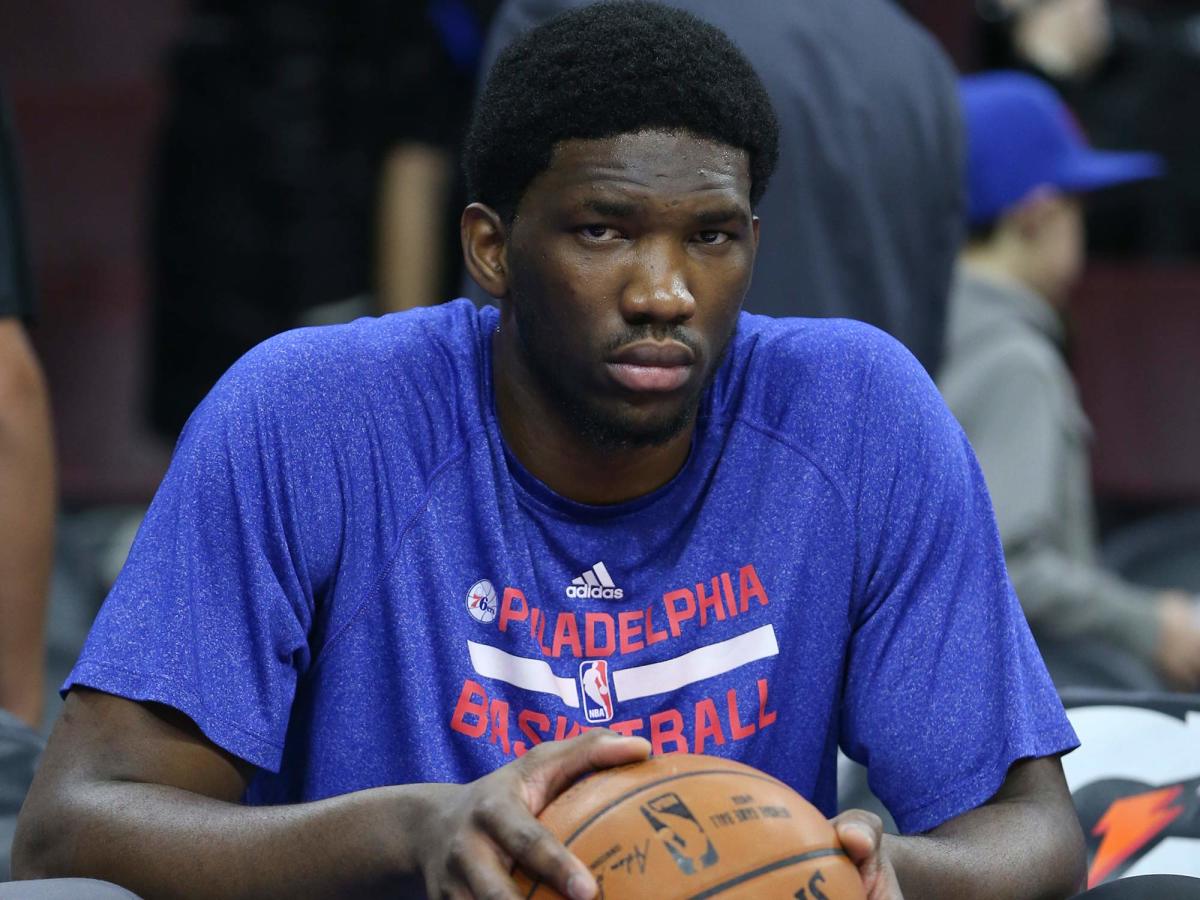
Last October, the day before the first anniversary of Arthur’s death, The Cauldron ran a distressing story about Embiid’s arduous rehab. Ensuing headlines focused on his exaggerated affection for Shirley Temples. You’d have thought he was chugging Moonshine laced with grenadine. Upset by both timing and content, Embiid considered quitting the NBA and returning to Cameroon, where he could honor his brother in peace. Maybe he’d go back to volleyball, his first chosen sport. His father had warned him about the dangers of hoops.
“I wanted to get away from all this drama,” Embiid recalls, “and stay away.” He had been in America for four years and lived in four cities, a hardwood nomad, always moving alone. “I never had a girlfriend before, but back then I had some type of girlfriend." Embiid says. “One day I told her my whole story.”
Russell Westbrook: 'I Was Never Going To Leave'
How he didn’t play basketball until 2010, when he caught an intoxicating glimpse of Kobe Bryant in the Finals against the Celtics. How he shot volleyballs into the rim at his high school, but was too embarrassed to try out for a local camp held by NBA forward Luc Richard Mbah a Moute. How his coach registered him anyway, prompting a scholarship offer from Montverde Academy in Florida, where as a junior he languished on JV. Even when Embiid signed with Kansas, he asked to be redshirted because Jayhawks kept dunking on him in pick-up games, and even when scouts slotted him ahead of prodigal teammate Andrew Wiggins, he told them he was not ready for the pros. But he was the presumptive No. 1 pick, and after he broke his foot during a pre-draft training session, the 76ers still took him third without so much as meeting him.
“I don’t know anything about basketball,” the girlfriend responded. “But all that sounds pretty amazing to me.” They eventually broke up, but her words stuck. “She’s right,” Embiid thought. “My life is like a movie.” His brother, whom he believes is watching, deserved to see the end.
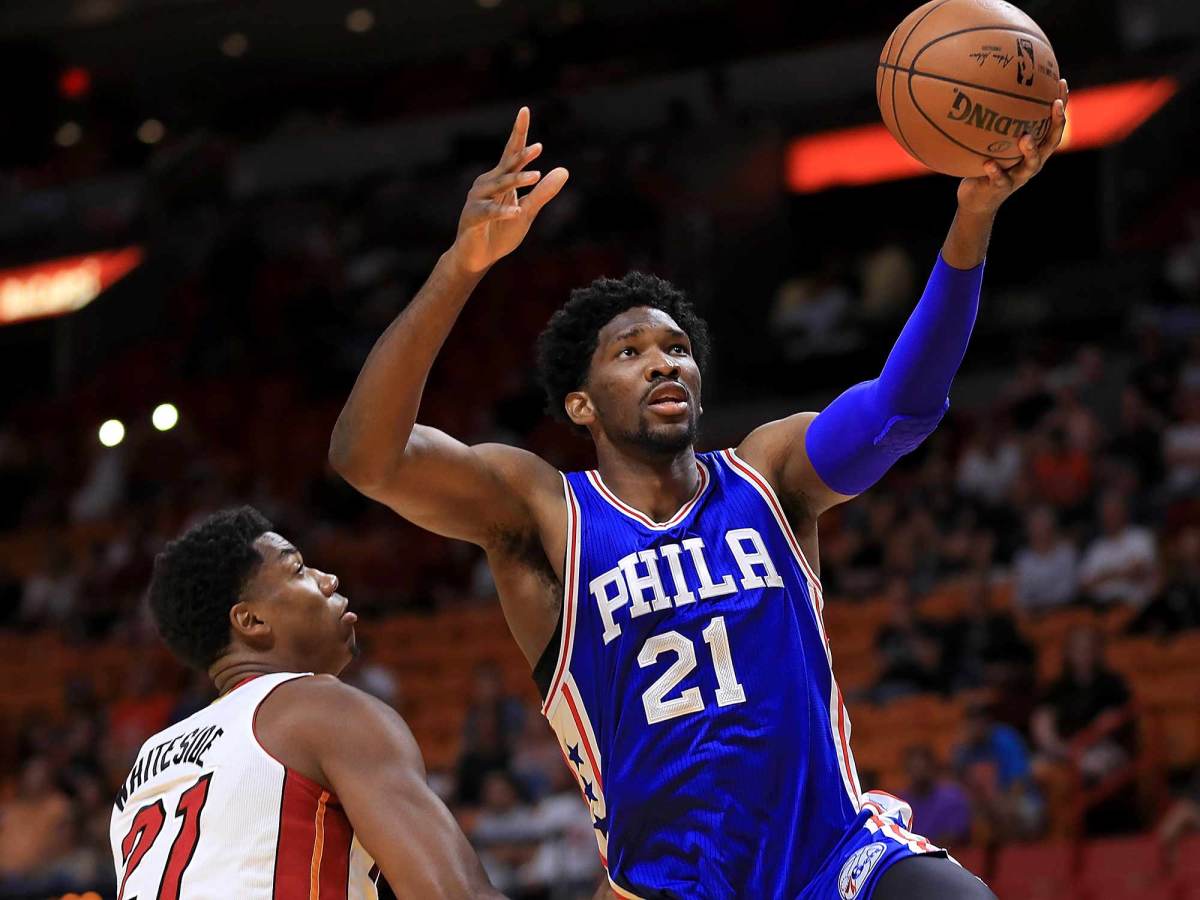
Another year passed, far better than the first, and the foot finally cooperated. He settled on a chef, a sleep schedule and a rehab regimen away from basketball. Eight days before his first regular-season game—and 844 days after the ’14 draft – Embiid sits on a second-floor balcony of the 76ers palatial practice facility in Camden, N.J. “Back on my feet,” he proclaims. Squinting through the midday sun, he points out his new apartment building, squeezed into the Philadelphia skyline. He has left the Ritz behind. “Fresh start,” he nods. When Embiid was injured, he did not grant interviews, so he has a lot to say. He speaks with a French accent, in a flowing stream of consciousness, about everything from Cameroon’s educational system to Florida’s topography to Marc Gasol’s jab step. He is engaging, charismatic and funny, but unlike many foreign big men, his humor is intentional. “You know how I learned to shoot?” Embiid says. “I watched white people. Just regular white people. They really put their elbow in and finish up top. You can find videos of them online.”
This is the Jo Jo you read on Twitter, the crackup who used to remind angry fans “yall got the same stats I do” and regale them with stories about women who told him to “come back when you’re a All Star.” The 76ers now experience his outsized charm in real life. “He’s found his release,” Brown says. Spinning past the Pistons’ Andre Drummond and racing around the Wizards’ Marcin Gortat, firing over the Cavaliers’ Kevin Love and powering through the Heat’s Hassan Whiteside, punctuating even preseason buckets with bicep flexes and primal roars. He scores in virtually every way imaginable, though his specialty is smothering guards and swatting centers. Offense and personality are a bonus.
He playfully protests the 76ers’ restrictions on his minutes. He launches technical foul shots before 90-percenters can intervene. He attempts to high five opponents after sinking free throws. In other words, he makes Philadelphia basketball worth watching, for the first time since Allen Iverson unfurled impossible fadeaways. And at the end of the day, he asks God and Adidas to protect his size-17s, because they’re all that can stop him.
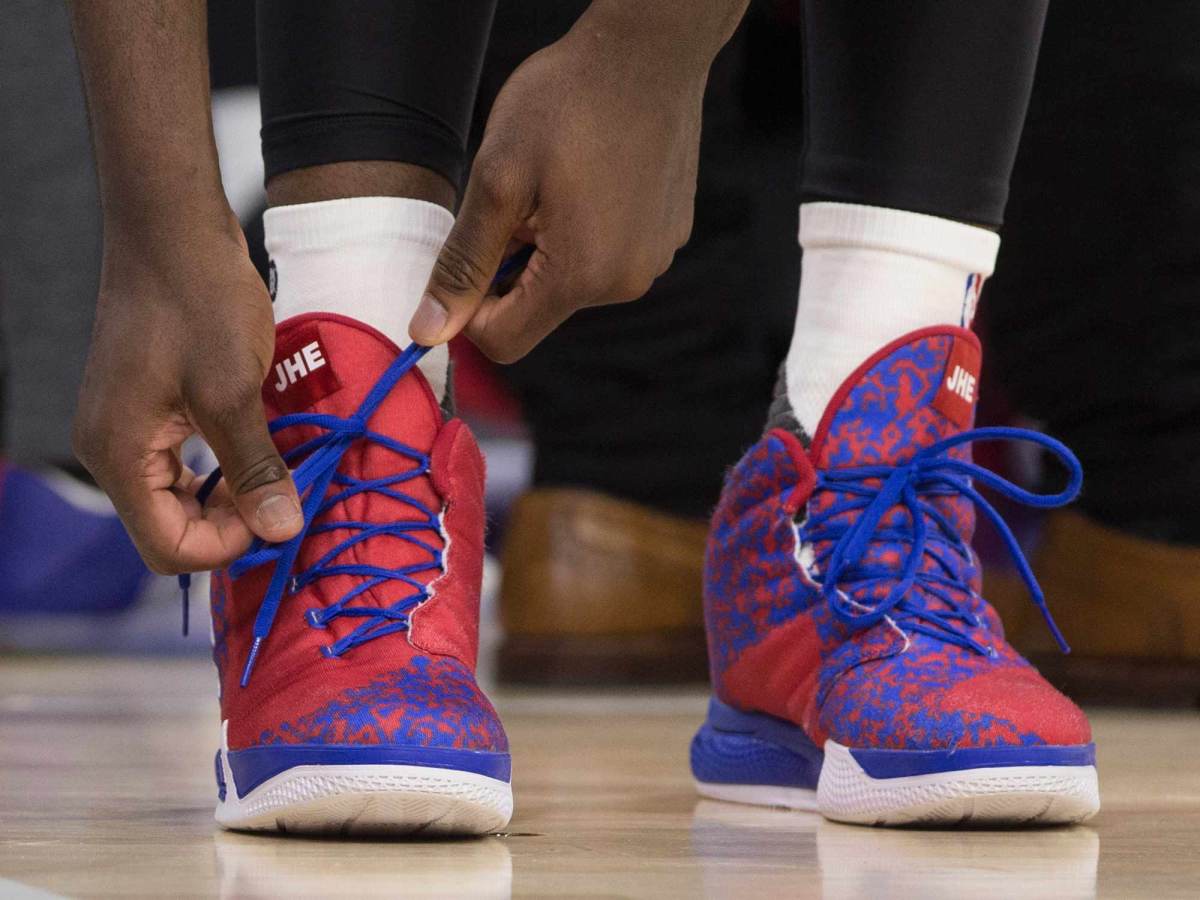
Embiid could have quit a long time ago. In his first week at Montverde, he learned how to say “good morning” in English, so he’d have something he could say to his American teammates in the locker room before 5 a.m. practices. When he finally worked up the courage to deploy the salutation, they laughed, and they did not stop laughing after he hit the court. “I couldn’t catch the ball,” Embiid recalls. “I got pushed around by everybody. I got my ass kicked every day.”
Embiid was raised in an upper middle class home in the Cameroonian capital of Yaounde. His parents made him wash his own clothes by hand, but they employed a maid. His mother drove a Mercedes. He ate omelettes for breakfast. He was not allowed to play sports until he had memorized all the notes he jotted throughout the day’s classes. “I was a little soft,” Embiid says, “but the Americans had no idea about any of that. They just knew I was from Africa. They thought I grew up poor, in the jungle, killing lions. I was like, If that’s how they think of me, I’m going to use it.”
As a boy, he created a persona on the soccer field, turning his cheerful countenance into an unnerving snarl. “Let’s say my team was down 2–0,” Embiid explains. “I’d put my arms out and make this mean face and try to scare everybody. I kind of liked that they were afraid of me.” He went back at his Montverde teammates, specifically five-star center Dakari Johnson, with moves stolen from a Hakeem Olajuwon video he studied six days a week. “Every day we fought,” Embiid remembers. “I had to make sure they stopped making fun of me. I had to let them know I came here for a reason.” Sometimes, Embiid got kicked out of practice, but he didn’t realize until later what coach Kevin Boyle was telling the team in his wake: “Someday, you’re going to be asking that guy for a loan.”
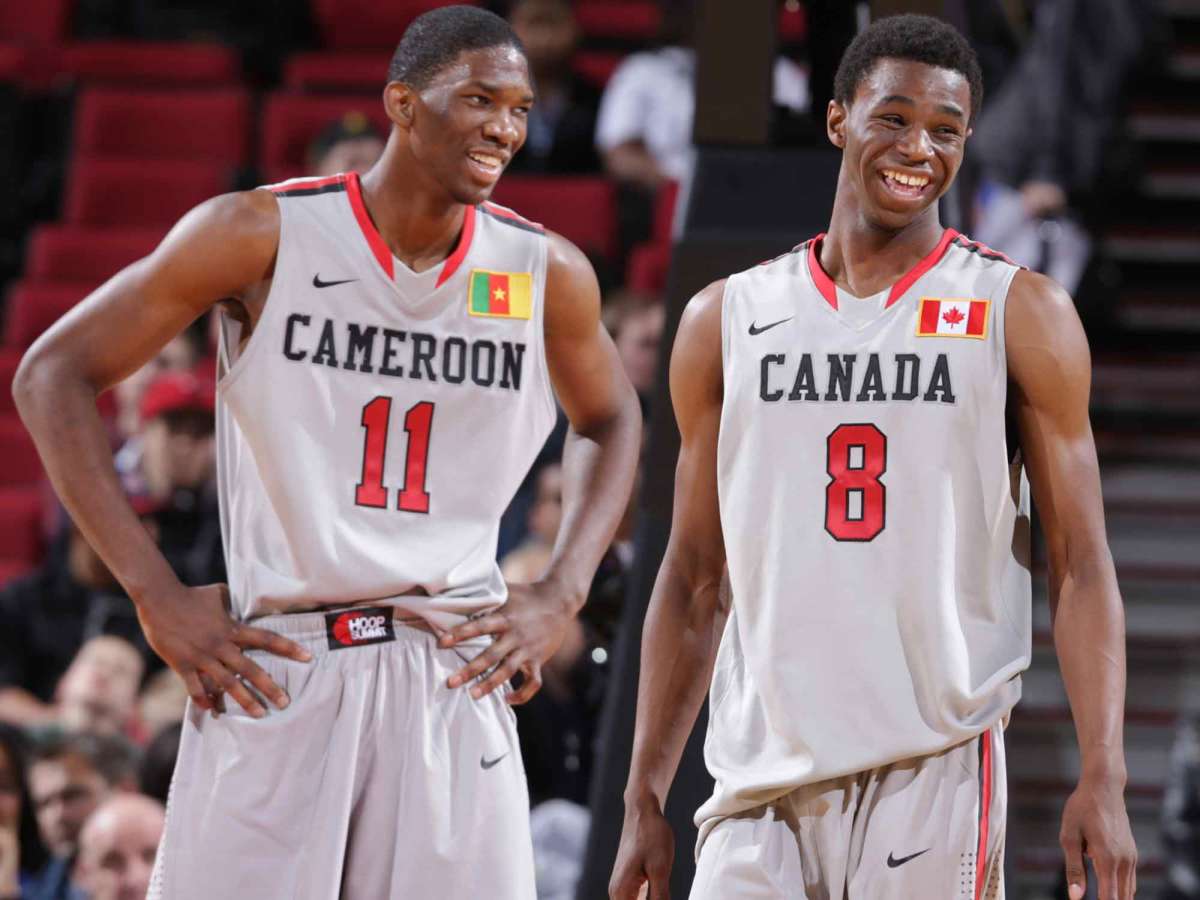
Three years, to be exact. “Everything in my life,” Embiid says, “happens really fast.” And then, with one inaudible crack during a predraft workout in Cleveland, all the action stopped. The 76ers scripted what seemed like a logical rehab plan for their prized rookie. They wanted him around the team at all times, home and road, so he would not feel isolated. They even acquired Mbah a Moute, who discovered Embiid at his camp in Yaounde, while running an unforgettable fast break. “The guard threw him a pass that was way ahead,” Mbah a Moute recounts. “Jo caught the ball, put it down, spun and finished on the other side of the rim in traffic. He’d been playing for six months. A normal person doesn’t do that.”
Embiid was supposed to go to France and enroll at INSEP (National Institute of Sports and Physical Education) for volleyball, and he swears he would have, had his countryman not intervened. Mbah a Moute directed Embiid to powerful Montverde, his own alma mater, but playing time there looked limited. So Mbah a Moute facilitated a transfer to The Rock School in Gainesville, Fla., where a blue-chipper was born.
As well as Mbah a Moute knew Embiid, even he could not predict the flaws in the 76ers rehab strategy. “They had me traveling all over the place, at every practice, every meeting, on the bench for every game,” Embiid says. “You’re sitting there, we’re losing, and you can’t do anything. It was the worst.” The stereotypical 7-foot import plays because he can. Embiid is different. He fell for basketball later than the average American guards and wings, but he fell just as hard. By stationing him next to the floor, and warning him not to step on it, the Sixers were tempting an addict.
No one believes the jumpers Embiid hoisted during his recovery had any tangible effect on the state of his foot. But the navicular bone, which was healing correctly according to five straight MRIs, suddenly reversed course late in the summer of 2015. Embiid, who was dominating the 76ers in pain-free pick-up games, sat stunned in a L.A. doctor’s office as he received the results. Philadelphia general manager Sam Hinkie and sports scientist David Martin flew west to see him the next morning. Martin was new to the organization and eager to meet Embiid, an inquisitive patient who demanded to understand the rationale behind his treatment.
• Fansided: Can Joel Embiid win Rookie of the Year? It's unlikely, here's why
When Embiid clashed with a Sixers strength and conditioning coach during a road trip in late ’14—a source says the staffer set him on a scale one too many times—he was sent back to Philadelphia. “Joel is a maverick,” Brown says. “He’s curious. He’s competitive. Those qualities are going to allow him to maximize his very evident gifts. But when he was out, those qualities sometimes made it a challenge to always walk that Boy Scout’s line.” Brown looked for something to scare Embiid—“Appropriate fear had to creep in,” the coach says. “‘Maybe I’m going to struggle to play basketball. Maybe there isn’t a light at the end of the tunnel’”—and the dreaded MRI did it.
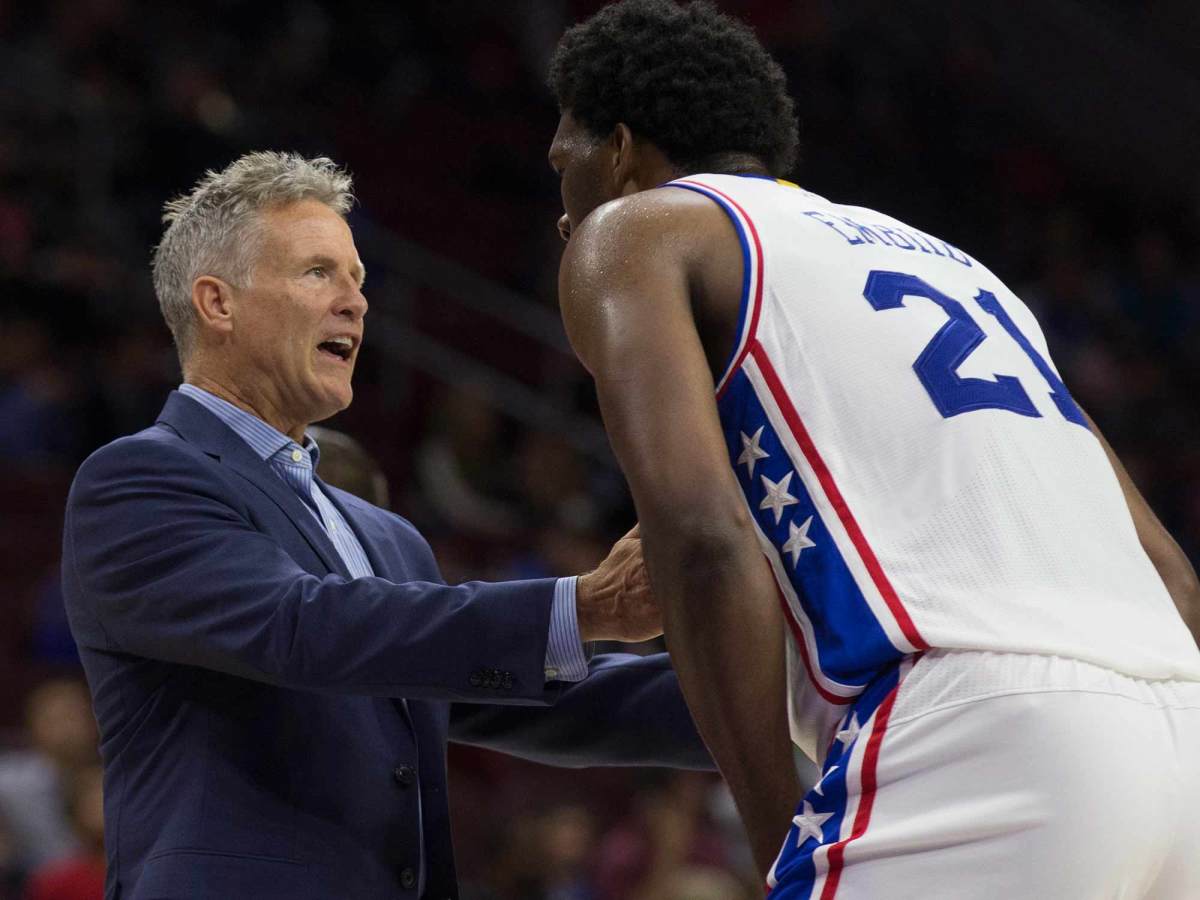
After confirming the diagnosis, Hinkie and Martin embarked on a new plan for Embiid’s second rehab. This time, they asked for his input. Embiid needed a mentor, so they set him up with Zydrunas Ilgauskas, another foreign-born center who endured the same injury. He needed a sanctuary, so they sent him to Aspetar, a renowned training facility in Qatar where he stabilized his sleep. And he needed his sanity, so he stayed away from the team, instead watching games from Hinkie’s suite. At the time, Hinkie was a controversial figure, architect of arguably the most dramatic teardown in sports history. Former Philly guard Tony Wroten famously dubbed it “The Process,” while others used harsher terminology. The 76ers won less than 20% of their games during Hinkie’s three-year tenure but accumulated a staggering cache of prospects and picks.
A divide formed, with casual fans deriding The Process and NBA junkies extolling it. Like many modern players, Embiid comes across as a de facto scout, evaluating the 20th pick in the draft, analyzing the Pacers’ spacing issues and recoiling at the sight of a defense switching a screen on J.J. Redick. If he sees a successful rip move, he doesn’t rewind it once or twice. He rewinds it 50 times. Once, be bumped into former 76ers general manager Tony DiLeo at the airport and spent the subsequent flight researching his transactions. He understands the lottery, the salary cap and the patience required to turn assets into stars. You can guess which camp he joined.
Hinkie was there for Embiid when Arthur died, sitting in his apartment with Brown and Mbah a Moute, then flying him to Cameroon for the funeral. He was there last season, when the Sixers nearly upset the Warriors at Wells Fargo Center, and Embiid stomped excitedly around the suite. He is not there anymore, having resigned in April, but Embiid channels Hinkie every time he references The Process, which occurs nearly every time he opens his mouth. “I think a lot about what I went through and how it prepared me to be a better man,” Embiid says. “I really feel like I’m The Process, like The Process is about me.”
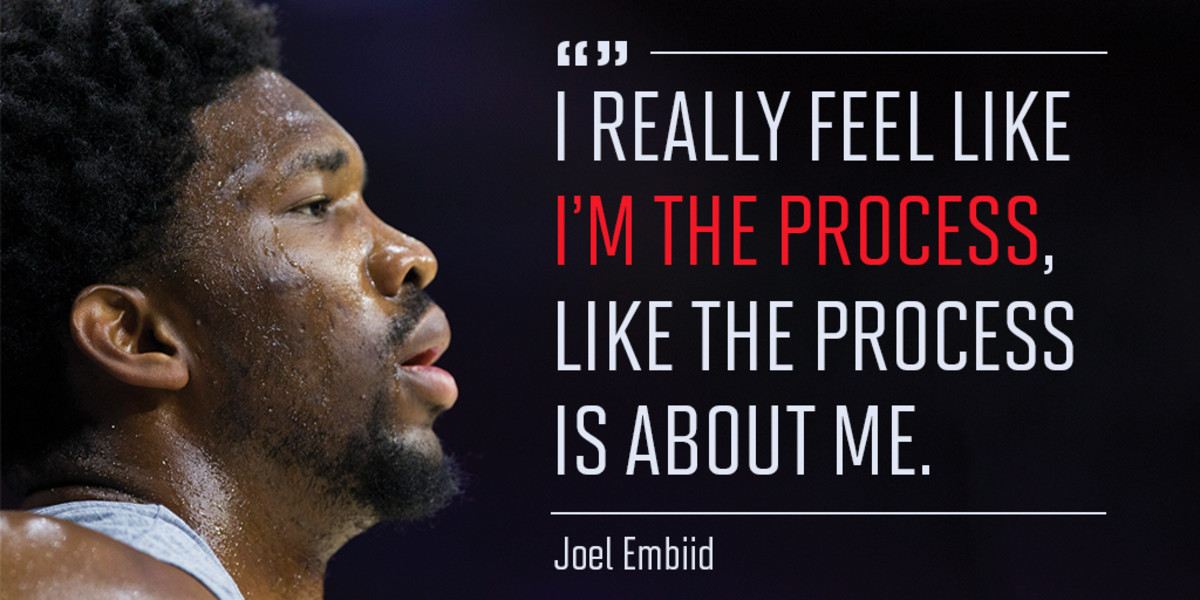
On Aug. 27, the 76ers hosted their annual Beach Bash at Jack’s Place on the Jersey Shore. At the end of the event, parched from all his socializing, Embiid ordered two Shirley Temples for the road. As he left, he took a sip, and beamed. The soda, the cherry, the grenadine, this was a mean Shirley Temple. He ducked back inside and autographed a shirt for the bartender: Best Shirley Temples Ever, Joel Embiid.
He is only 22 and already recognizes, better than public figures twice his age, how to neutralize criticism in the clickbait era. Same way he dealt with the boys at Montverde who assumed he emerged from the jungle. Own it. Embrace it. Tweet a beefcake pic over the hashtag #shirleytempledidthis, as Embiid did last winter, and watch the 76ers add the drink to their club menu, as they plan to do this fall.
Embiid’s preferred mocktail is as incongruous as his taste in recreation. He watches cycling and plays tennis, often at night, on an outdoor public court across the Schuylkill River with 76ers development coach Chris Babcock. “You’d expect him to hit the ball really hard, right?” Babcock says. Embiid is actually a finesse player and a drop-shot artist. He is self-taught, in tennis as well as basketball, an audacious copycat of both Shaq and Fed.
At the Las Vegas Summer League in July, Embiid approached NBA skills coach Drew Hanlen because he was intrigued by the work Hanlen had done in the mid-post with Wiggins. “Sorry,” Hanlen said, “I have to be back in L.A. tomorrow.” “Perfect,” Embiid replied, “I’ll see you there.” They spent two weeks together, and after a break, another two weeks. Embiid posted some clips of himself, running figure eights around Hanlen, to show his progress. “Those videos went viral for two reasons,” Hanlen says. “Because people thought, ‘Oh my God, this guy has a chance to be very special.’ And because he was doing it against a 5' 11" white guy.” The Ringer published a hilarious six-minute spoof.
Laugh now, because Embiid is going to be a problem, the term his teammates use. He can roll to the rim or pop to the perimeter, strong enough to find whatever spot he wants, whether the man in front of him stands 5' 11" or 6' 11". “And he talks a lot,” laughs center Jahlil Okafor, another member of the 76ers brimming frontcourt. “Post me up! This guy can’t guard me!” Embiid hollers, annoying but accurate.
• GALLERY: The weird, wild world of Joel Embiid on social media
Technically, he is still a rookie, and he does not hide his zeal. Embiid was sick for his first practice at Stockton University in New Jersey, and the 76ers advised him to stay home. But he’d done enough of that already. He couldn’t miss another day. In his preseason debut against the Celtics, he airballed his opening shot, blaming the accumulated adrenaline. He settled quickly, averaging 32.2 points and 16.9 rebounds per 40 minutes over the exhibition schedule, jacking expectations in Philly from unreasonable to absurd.
A week before opening night, the Sixers held a public practice at Temple’s Liacouras Center, and afterward most players showered and left. Embiid hung around for 40 minutes, circling the lower bowl, scribbling autographs and snapping selfies. Fans chanted his name. They told him they loved him. One teenage boy claimed to be his father. Embiid liked that one. Two security guards rushed alongside him. “Be careful,” they warned the crowd. “Don’t grab him. Don’t push him.”
He finally ducked into the tunnel, the last to go, having posed for hundreds of pictures. But in none of them did he actually smile. He opted instead for the steely expression he wore on the soccer field as a boy, when his team was tired of losing and the time had come to dispense the fear.
